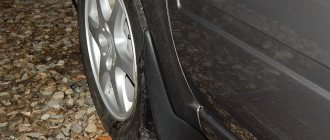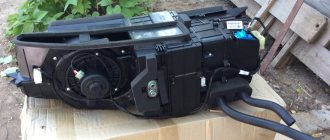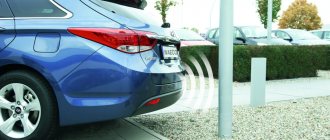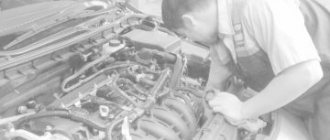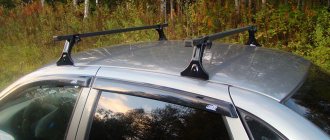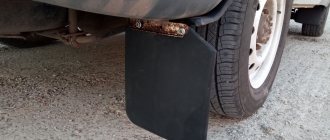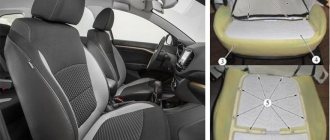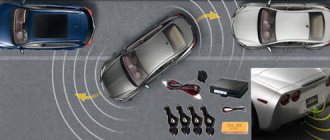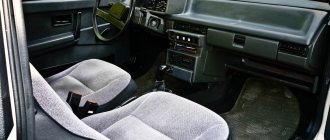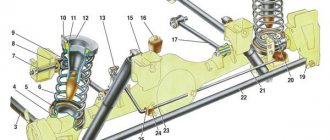Types of mud flaps
Mud flaps (hereinafter referred to as protection) are made of impact-resistant rubber and plastic adapted to temperature changes.
The former are more resistant to damage and wear. The material from which they are made is elastic and does not break when bent, which is very convenient when overcoming road obstacles, uneven surfaces, and potholes.
Plastic accessories are purchased less often than rubber ones. It's not even a matter of price, but the systematic accumulation of dirt and moisture in the grooves of the sidewalls.
Among the advantages of plastic is “holding” its shape when moving at high speeds. At the same time, even a shallow pothole on the road will deform the plastic protection.
The final choice of mudguard remains with the owner of the technical equipment. If necessary, get advice from service station specialists regarding the compatibility of protection with your car model.
Selection of mud flaps for Lada Vesta
Front mudguards of Lada Vesta There are options on the market made from two materials:
Each of them has its own performance properties.
Rubber models
Rubber mud flaps are considered traditional for Russian cars. They are inexpensive and have good elasticity, which minimizes damage and does not impair the aerodynamics of Vesta. Cleaning these shields is not difficult.
Do-it-yourself rear mudguard installation on Lada Vesta
Necessary tools for work:
- wheel wrench;
- electric drill;
- Phillips screwdriver;
- metal brush;
- new protection kit.
How to install mudguards. Step-by-step replacement guide
- We place the car above the inspection channel.
- We squeeze the handbrake and turn off the ignition.
- Jack up the rear of the car and remove the wheel.
- We clean (rinse) the rear part of the wheel arch where the fender liner is attached.
- Unscrew the two lower screws that secure the fender liner to the car body.
- We apply protection and outline the location of future holes.
- We drill holes with a drill and lubricate them with grease to prevent the development of corrosion.
- We fix the mudguard with self-tapping screws, which are supplied with the accessory.
- We put the wheel on the studs and lower the car into the transport position.
- Do-it-yourself replacement of rear mudguards is completed.
Do you need mudguards for the Lada Vesta SV?
Mud flaps are a kind of bumper that allows you to protect the car body from stones, dirt and sand flying out from under the Vesta Cross tires. If there are no mudguards, then everything that flies from under Vesta’s wheels will sandblast the car’s paintwork and over time the car will lose its appearance. And stones flying out from under the car can fly into cars from behind and cause damage to them. With installed mudguards, such situations should not arise.
On the simple Lada Vesta SV station wagon in any configuration there are only front mudguards, and the all-terrain version SW Cross does not have them at all. Many car owners prefer to install wider mud flaps, which do their job most effectively. Thus, the front mudguards of the Lada Vesta SV protect not only the paintwork of the car, but also the bottom.
Review of Manufacturer Prices
| Serial number/catalogue number | Price in rubles |
| AvtoVAZ Rear 99999218001382 | From 1100 |
| Novline 89108-0-147-2689 | From 1100 - 1200 |
| 89109-73-147-2689 | From 1100 - 1200 |
| Guard VS-ZBLV | From 900 |
| Avtodriver AVTMODEL2 | From 900 |
| AVTMODEL1 | From 900 |
| NLF 52.33.E10 | From 900 |
| *prices are as of May 2019 | |
Buying mudguards: prices and manufacturers
A sufficient period of time has passed since the start of sales of the West sedan and station wagon. Today there is already the possibility of a wide selection of accessories suitable for both types of Lada vesta body. Let's focus on the most worthy manufacturers. There is no point in considering Vesta's standard protective accessories. They do not please with the variety of design options and prices (VAZ produces them from polyurethane). Let's also forget about universal ones - they need to be additionally prepared before installation by “adjusting” the fasteners and sizes. Below is a table with the names of manufacturers. Below are approximate prices in Russian rubles for goods intended for the West (the cost of a pair is indicated, the price includes an installation kit with instructions):
- Novline - RUB 1,300.00;
- Seintex - RUB 1,200.00;
- LLocker—RUB 750.00;
- AvtoDriver - RUB 750.00;
- NorPlast - RUB 1,000.00;
- NLF - RUB 1,000.00;
- Guard - 800.00 rub.
Installing the latter eliminates the need for a drill - factory-prepared holes are sufficient.
The price of front and rear ones from the same manufacturer is almost the same. The most expensive ones are made of polyurethane; they have the properties of resisting external factors: wear is reduced by 3 times compared to rubber, and the strength of the material is 22.5 times.
For Lada Vesta vehicles, mudguards are suitable for installation on all existing body types of the model range of new AvtoVAZ products. We consider it necessary to provide the article number of the standard front mudguards - 99999218111382. The article number of the mudguards installed on the rear wheels differs insignificantly - 99999218001382. By entering the specified order of numbers into the search, the computer user will find offers to buy original products from VAZ and duplicates produced by third-party companies.
The Vesta crossover and station wagon, fortunately or unfortunately, are not endowed with a special shape and catalog number for both types of mudguards. Therefore, owners of a regular SW station wagon and an “elevated” one in the interests of successfully fighting the treachery of Russian roads, a “brother” with the ending “Cross” in the name, will not have any problems finding and having the part. You will find the catalog number of the accessory in the previous subparagraph, going up a few lines.
The article numbers for sedans are no different from the article numbers for station wagons.
Conclusion
Installing rear mud flaps is necessary and important to protect the wheel arches of the car. Regarding the material of the accessory, this is a personal matter: rubber or plastic. The decision on the choice is made by the owner of the vehicle.
Workers at a number of certified workshops insist on purchasing rubber protection, which will extend the life of the mudguard to several years.
Reviews
| № | Positive |
| 1 | Andrey (Avtodrom): in the third year of operation of the car, I installed mudguards. The process is not at all complicated, but it does not forgive mistakes. |
| 2 | Sergey (Avtotema): I’m pleased with the domestic plastic protection, although my comrades dissuaded me, saying they were impractical in the pits. |
| 3 | Kirill (Autoreview): I’ve been riding on domestic fenders for two seasons now, there are no comments on the quality. |
| 4 | Alexey (Avtoria): I ordered the installation of the fender liner at a service station, the guys completed it in half an hour. Provided a one year warranty on the accessory. |
| 5 | Alexander (Drom): I installed the wheel arch protection on my own, for the first time, I thought it wouldn’t work. Half an hour and the protection is installed. |
| 6 | Stanislav (Driving): the protection is good, practical, and does not deform in the cold. |
| 7 | Vasily Alekseevich (“5th wheel”): I rode on rubber protection for two seasons, there were no problems, I think it will last the same amount. |
| Negative | |
| 8 | Vitaly (Avtotema): the plastic protection burst in the first winter when driving through snowdrifts. After installing rubber ones, the quality is better than plastic, more elastic in the cold. |
| 9 | Svyatoslav (Otzovik.net): the rubber cracked after a year and a half from the date of operation. I don’t know what to do, I’ll buy a new one. |
| 10 | Vlad (ProAvto): there are no particular complaints about the plastic, but in heavy snow a large amount of ice accumulates between the wheel and the wheel arch. |
Installation
When you choose mud flaps in a store or on the market, remember that the average estimated cost for one set is at least 1300 - 1500 rubles.
More expensive, there is also no point in buying.
Before you begin installing this part, you will need to carry out some preparatory procedures. The first thing you need to do is remove both rear wheels from the Lada Vesta. Next, using a special brush, clean the surface of the arch from all dirt and let it dry completely.
Now that the surface of the arch is cleaned and prepared for installation, it is necessary to mark the places on it where the screws that secure the mud flaps to the body will go. To fasten this part, it is recommended to use screws measuring 4.2 mm in diameter and no more than 15 mm in length.
After the holes are made in the body, treat them with anticorrosive. Next, install the rear mudguards in their places, on the same side as the front ones. Now you can safely fasten them and check how tightly they fit.
This completes the work of installing mudguards on the Lada Vesta car. It is worth noting that it is not necessary to buy mud flaps specifically for this model. A cheaper and higher quality option may be products from Sparco and Elegant.
Does Vesta need rear mudguards?
The answer to this question should be a resounding “Yes!” As practice shows, neglecting this component negatively affects the condition of the body. It is vulnerable to water, sand, dirt and various reagents. All this provokes the occurrence and spread of corrosion, as well as damage to paintwork on plastic components (rear bumper and others). In addition, during fast driving, the body is exposed to air flow, which also becomes a source of various types of contaminants.
Without mudguards, rapid wear of the paintwork is guaranteed.
Therefore, Vesta mud flaps are definitely necessary, as this will significantly increase the body’s chances of resisting adverse factors.
Which material is better?
The most popular and in demand material for the manufacture of these parts on the Lada Vesta is rubber. This material can withstand various loads well, it is flexible and elastic, not brittle and brittle. The rubber adapts to any conditions dictated by the track; dirt and water easily drain from them.
Rubber accessories do not affect the aerodynamics of the car, as they adjust and change their position depending on the driving speed. The disadvantage of this material for making mud flaps is that the rubber is prone to aging and wear. On average, rubber products need to be replaced every year and a half, as they wear out and become unusable. Rubber can change its properties depending on the ambient temperature. In severe frost, rubber of this type heats up, and such mud flaps often crack and break.
Self-installation
As a rule, installing mud flaps in any car and in the Lada Vesta in particular does not cause much difficulty and can be done independently in a garage.
| What you will need | What to pay attention to |
| Tools: brush for cleaning the work surface, drill, Phillips screwdriver and self-tapping screws - if the purchase does not include all fasteners. | Experienced car owners recommend using self-tapping screws with a diameter of 4.6 mm and a length of 15 mm. |
| During the work, you will need to remove the rear wheels. Also, in addition to a couple of standard holes, additional drilling will be required. | As a rule, you need to drill two more holes with a diameter of 5 mm, which are best done at an equal distance from the existing ones. However, the instructions included in the kit will tell you how many and what holes are needed. |
| During installation, it is important not to forget to treat the surface with an anti-corrosion agent. | In general, this is the entire installation process. Complications can only arise if the size of a universal model is adjusted. |
Whether or not to install rear mudguards on Vesta is a personal question for each car owner. But stones and dirt flying onto cars behind you from under the wheels of your iron horse will not add status to you. And the general appearance of the car has long been formed, which seems somehow unfinished without rear mudguards.
The price of the issue is not so high (from 750 rubles for a universal unknown model to 1300 for an original AvtoVAZ kit) to give up such obvious advantages.
It just so happens that the new AvtoVAZ product is not equipped with mud flaps from the factory. Although the mudguards of the Lada Vesta SV are a very important and necessary attribute. But they don't come from the factory. I don’t know what this is - a design miscalculation, a desire to reduce the cost of the design or to make extra money on accessories from dealers. Although you can buy mud flaps for the Lada Vesta SV Cross. And no problem at all.
For many modern budget, and not only foreign cars, the absence of mudguards is a common occurrence. Perhaps Vesta’s designers followed the same path as their foreign colleagues.
